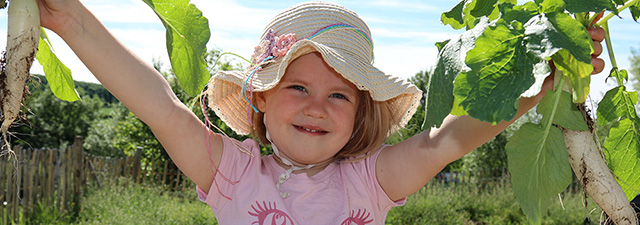Starting a veggie patch
Nothing is more fun than harvesting fresh vegetables from your own garden. And it’s quite easy! That’s why we listed the seven do’s when starting a vegetable garden: the most important steps to begin with, so you can start immediately. It doesn’t even have to be in spring time, but can be done throughout the year.
1. The right spot
Like with houses, it’s all about location, location, location. When you’re starting a vegetable garden for the first time, draw out your garden on a piece of paper, and draw the line of the rising (east) and setting sun (west). Make sure the segment you are choosing has the most sun hours. Think about what crops you’d like to grow before picking the right spot. Some vegetables like tomatoes need about 6 hours of sun each day, while some herbs like mint prefer the shade. Don’t start too big! That’s probably not going to inspire, but tire you.
2. Loosening and covering
If you are going to develop grassland or another overgrown area of land, first remove the vegetation in order to loosen the upper layer. If about 20 cm of the ground is loose, you don’t have to dig further. Thoroughly remove all weeds and provide nutrients for the soil. We developed Aptus All-in-One pellet to enrich the soil in one time, fully organic with a slow-release effect.
Covering the opened soil with root cloth is very important. This gives the weeds little chance and it also reduces the washing away of minerals due to rainfall.
3. Collecting compost
Of course you don’t throw away garden waste! You can use everything to make compost. There are different systems for composting, like in a barrel or box, but an open compost heap is just as easy. Here’s an example.
4. Layouts and lots
Divide your vegetable garden into sections and grow one crop per piece of land at the beginning. It doesn’t matter how big the sections are, just make it clear to yourself and never grow the same crop for two consecutive years on the same section.
5. Planning
Make a plan for the entire season. What do you want to grow and taste? What do you like? Do you want fresh lettuce every day? Do you want to completely meet your need for vegetables? Do you want to grow special vegetables that are not available in the store? Depending on the climate in which you live, you choose to follow a local sowing calendar. You can take into account companion crops. Some crops benefit when they are grown together. For example, if you plant garlic close to your strawberries, the garlic will keep insects at a distance.
6. Start indoors
In the open ground you can only start sowing (or transplanting) from April or May. Therefore it’s smart to germinate and grow out your plants inside and let them harden up. You could put them in a little greenhouse and later in separate pots. When the time is you place them into the open soil.
7. Regular maintenance
Maintain your vegetable garden regularly. Remove weeds, give water and nutrition. Harvesting in time is also important to get optimal yields during the season. We use Aptus Regulator and Startbooster to achieve all our results. Read our blog about some amazing testresults here.
For now we wish you a lot of fun and keep your eyes and ears open. Gardening is almost as old as humanity, there’s a lot to learn.
Good growings!





